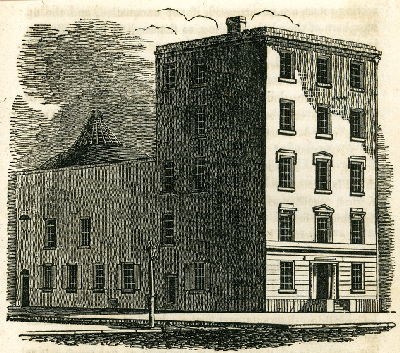Part of a series of articles titled A Great Inheritance: Examining the Relationship between Abolition and the Women’s Rights Movement.
Article
A Great Inheritance: Abolition and the Women's Sphere
This article is part of a series, "A Great Inheritance: Examining the Relationship between Abolition and the Women's Rights Movement" written by Victoria Elliott, a Cultural Resources Diversity Internship Program (CRDIP) intern at Women's Rights National Historical Park.

The Stranger's Guide in Philadelphia and its Environs. (Philadelphia: Lindsay & Blakiston, 1854)., p. 97-99
Prior to the 1830s, American antislavery organizations were formed and controlled by white men.[1] This changed in December of 1833 when African American men were invited to participate at the first convention of the American Anti-Slavery Slavery Society (AASS) held in Philadelphia.[2] Some women were also invited to the convention, but as spectators rather than as members. Excluding women from full participation was customary of the period’s social conventions. However, this practice was challenged by Lucretia Mott, a Quaker from Nantucket. Hearing a fault in the AASS’ “Declaration of Sentiments,” she stood to speak, and after some encouragement, noted the flaw in the wording of an important sentence. Her recommended amendment was agreed upon and adopted into the final document.[3]
Women abolitionists who began their participation in the anti-slavery movement through religious benevolent activities engaged in more secular activities as the abolitionist movement secularized.[9] Garrisonian abolition in particular was not allied with religious rule. As a perfectionist, William Lloyd Garrison believed that individuals were capable of being free from sin. Although individuals could be pure, earthly institutions, like the church or the government, had been formed by a humanity of sinners. The logic followed that these institutions prevented humankind from achieving holy perfection. Therefore, individual piety was respected above any religious rule. The church, which constrained women’s energies and prevented religious activism from becoming political activism, was thus challenged by Garrisonian abolitionists who championed individual piety over institutional piety.[10] No longer subject to clerical authority, “Garrisonian abolition armed women with faith in their own convictions.”[11]
Notes:
[1] Williams, Carolyn. ‘The Female Antislavery Movement: Fighting Racial Prejudice and Promoting Women’s Rights in Antebellum America” The Abolitionist Sisterhood: Women's Political Culture in Antebellum America, edited by Jean Fagan Yellin, John C. Van Horne, Cornell University Press, 2018, pp. 159.
[2] Proceedings of the anti-slavery convention, assembled at Philadelphia, December 4, 5, and 6, 1833. E-book, New York, 1833.
[3] Friedman, Lawrence J. Gregarious Saints: Self and Community in American Abolitionism, 1830-1870. Cambridge University Press, 1982, pp. 131.
[4] Proceedings pp. 17.
[5] Friedman pp. 130.
[6] Welter, Barbara. “The Cult of True Womanhood: 1820- 1860.” American Quarterly, vol. 18, no. 2, pp. 152.
[7] Welter, pp. 152.
[8] Fitts, Robert. “The Rhetoric of Reform: The Five Points Missions and the Cult of Domesticity.” Historical Archaeology, vol. 35, no. 3, pp. 116-117.
[9] DuBois, Ellen Carol. Feminism and Suffrage: The Emergence of an Independent Women’s Movement in America, 1848- 1869. Cornell University Press, 1978, pp. 33.
[10] Wiecek, William M. The Sources of Anti-Slavery Constitutionalism in America, 1760-1848. Cornell University Press, 2018, pp. 283- 287.
[11] DuBois, pp. 32.
Tags
Last updated: November 19, 2020
